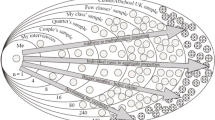Abstract
We distinguish two conceptions of sample and sampling that emerged in the context of a teaching experiment conducted in a high school statistics class. In one conception ‘sample as a quasi-proportional,small-scale version of the population’ is the encompassing image. This conception entails images of repeating the sampling process and an image of variability among its outcomes that supports reasoning about distributions. In contrast, a sample may be viewed simply as ‘a subset of a population’ – an encompassing image devoid of repeated sampling, and of ideas of variability that extend to distribution. We argue that the former conception is a powerful one to target for instruction.
Similar content being viewed by others
REFERENCES
delMas, R.C., Garfield, J. and Chance, B.L.: 1999, Exploring the Role of Computer Simulations in Developing Understanding of Sampling Distributions, Paper presented at the American Educational Research Association, Montreal.
Glasersfeld, E. v.: 1995, Radical Constructivism: A Way of Knowing and Learning, Falmer Press, London.
Harel, G. and Confrey, J. (eds.): 1994, The Development of Multiplicative Reasoning in the Learning of Mathematics, SUNY Press, Albany, NY.
Inhelder, B. and Piaget, J.: 1964, The Early Growth of Logic in the Child: Classification and Seriation, W.W. Norton and Company Inc., New York.
Kahneman, D. and Tversky, A.: 1982, ‘Variants of uncertainty’,’ in D. Kahneman, P. Slovic and A. Tversky (eds.), Judgment under Uncertainty: Heuristics and Biases, Cambridge University press, New York, pp. 509–521.
Kahneman, D. and Tversky, A.: 1972, ‘Subjective probability: A judgement of representativeness’,’ Cognitive Psychology 3, 430–454.
Konold, C.: 1989, ‘Informal conceptions of probability’,’ Cognition and Instruction 6(1), 59–98.
Rubin, A., Bruce, B. and Tenney, Y.: 1991, Learning about Sampling: Trouble at the Core of Statistics, In D. Vere-Jones (ed.), Proceedings of the Third International Conference on Teaching Statistics, ISI Publications in Statistical Education, Dunedin, New Zealand, Vol. 1, pp. 314–319.
Saldanha, L.A. and Thompson, P.W.: 2001, ‘Students' reasoning about sampling distributions and statistical inference’,’ in R. Speiser and C. Maher (eds.), Proceedings of the Twenty Third Annual Meeting of the North American Chapter of the International Group for the Psychology of Mathematics Education, ERIC Clearinghouse for Science, Mathematics, and Environmental Education, Columbus, OH, Snowbird, Utah, Vol. 1, pp. 449–454.
Schwartz, D.L., Goldman, S.R., Vye, N.J. and Barron, B.J.: 1998, ‘Aligning everyday and mathematical reasoning: The case of sampling assumptions’,’ in S.P. Lajoie (ed.), Reflections on Statistics: Learning, Teaching, and Assessment in Grades K-12, Lawrence Erlbaum Associates, Mahwah, NJ, pp. 233–273.
Sedlmeier, P.: 1999, Improving Statistical Reasoning: Theoretical Models and Practical Implications, Lawrence Erlbaum, Mahwah, NJ.
Sedlmeier, P. and Gigerenzer, G.: 1997, ‘Intuitions about sample size: The empirical law of large numbers’,’ Journal of Behavioral Decision Making 10, 33–51.
Shaugnessy, J.M., Watson, J., Moritz, J. and Reading, C.: 1999, School Students’ Acknowledgment of Statistical Variation, Paper presented at the Research Presession Symposium of the 77th Annual NCTM Conference, San Francisco, CA.
Simon, M.A.: 1995, ‘Reconstructing mathematics pedagogy froma constructivist perspective’,’ Journal for Research in Mathematics Education 26(2), 114–145.
Steffe, L.P. and Thompson, P.W.: 2000, ‘Teaching experiment methodology: Underlying principles and essential elements’,’ in A.E. Kelly and R.A. Lesh (eds.), Handbook of Research Design in Mathematics and Science Education, Lawrence Erlbaum Associates, inc., Mahwah, NJ, pp. 267–306.
Thompson, P.W. and Saldanha, L.A.: in press, ‘Fractions and multiplicative reasoning’,’ in J. Kilpatrick and G. Martin (eds.), Research Companion to the Principles and Standards for School Mathematics, NCTM, Reston, VA, pp. 95–114.
Thompson, P.W. and Saldanha, L.A.: 2000, ‘Epistemological analyses of mathematical ideas: A research methodology’,’ in M.L. Fernandez (ed.), Proceedings of the Twenty Second Annual Meeting of the North American Chapter of the International Group for the Psychology of Mathematics Education, ERIC Clearinghouse for Science, Mathematics, and Environmental Education, Columbus, OH, Tucson, AZ, Vol. 2, pp. 403–408.
Watson, J.M. and Moritz, J.B.: 2000, ‘Developing concepts of sampling,’ Journal for Research in Mathematics Education 31(1), 44–70.
Author information
Authors and Affiliations
Rights and permissions
About this article
Cite this article
Saldanha, L., Thompson, P. Conceptions of sample and their relationship to statistical inference. Educational Studies in Mathematics 51, 257–270 (2002). https://doi.org/10.1023/A:1023692604014
Issue Date:
DOI: https://doi.org/10.1023/A:1023692604014




